Social Media Marketing Persuasiveness Compared to Traditional WOM
VerifiedAdded on 2023/06/11
|22
|4975
|109
Report
AI Summary
This report investigates the increasing persuasiveness of social media marketing compared to traditional word-of-mouth (WOM) marketing, particularly within the Australian market. It acknowledges the shift in consumer behavior due to the rise of social media platforms like Facebook, Twitter, Instagram, and YouTube, which have impacted marketing strategies. The research aims to understand why social media is becoming more influential in consumer purchasing decisions than traditional face-to-face marketing. The report uses attribution theory to explain consumer behavior and will employ both qualitative and quantitative research methods to gather data from customers and business owners. The data will be analyzed using descriptive, correlation, and regression techniques to provide a comprehensive understanding of the factors driving the persuasiveness of social media over traditional WOM marketing.
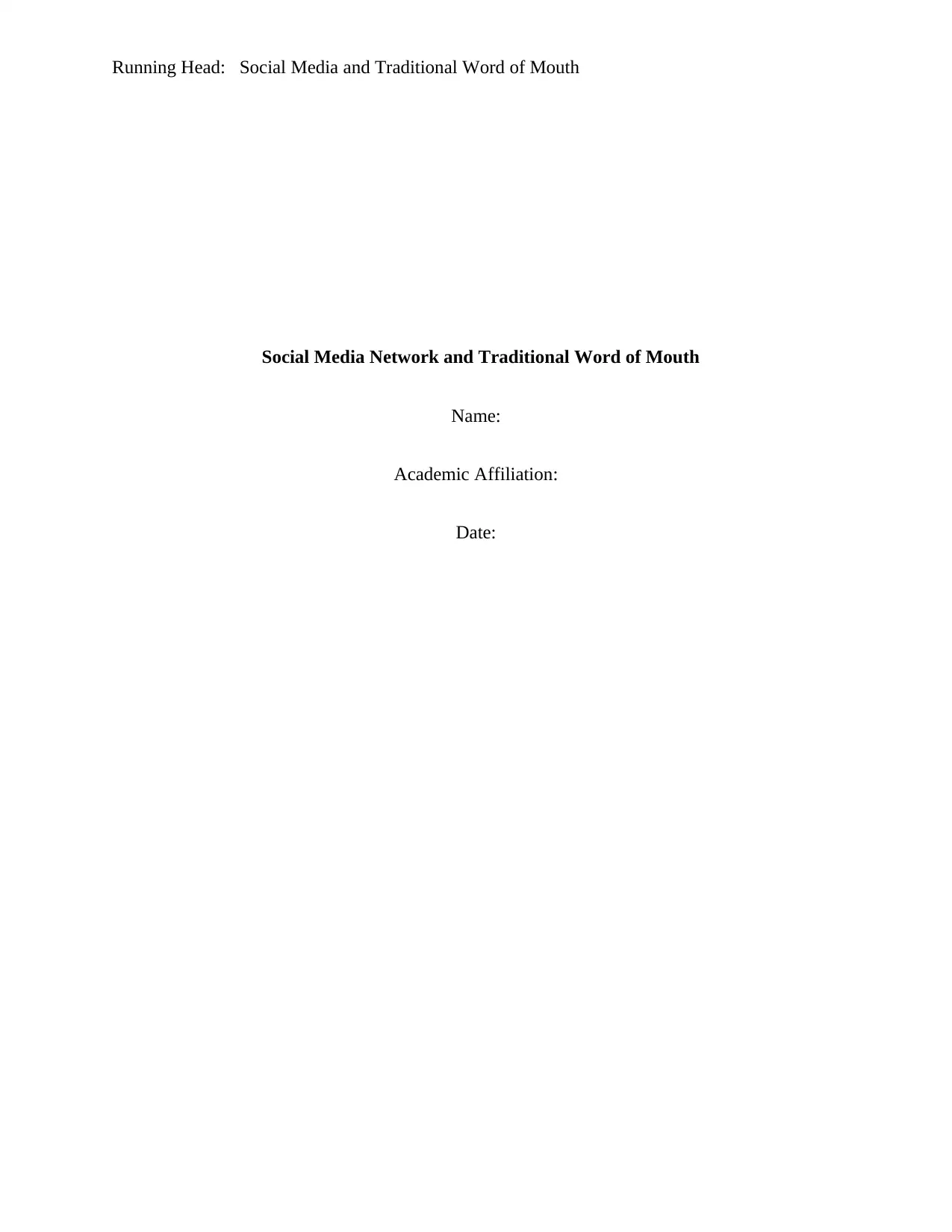
Running Head: Social Media and Traditional Word of Mouth
Social Media Network and Traditional Word of Mouth
Name:
Academic Affiliation:
Date:
Social Media Network and Traditional Word of Mouth
Name:
Academic Affiliation:
Date:
Paraphrase This Document
Need a fresh take? Get an instant paraphrase of this document with our AI Paraphraser
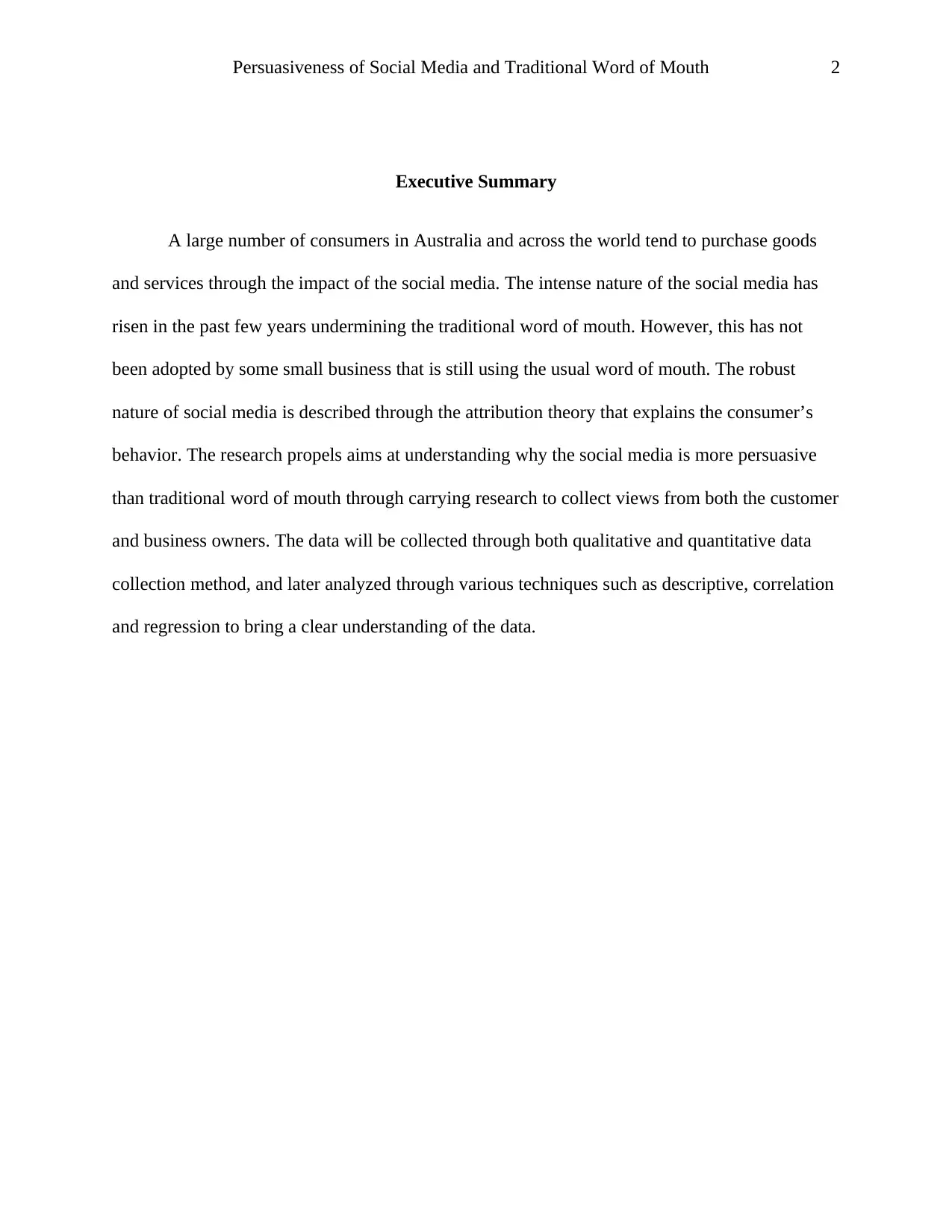
Persuasiveness of Social Media and Traditional Word of Mouth 2
Executive Summary
A large number of consumers in Australia and across the world tend to purchase goods
and services through the impact of the social media. The intense nature of the social media has
risen in the past few years undermining the traditional word of mouth. However, this has not
been adopted by some small business that is still using the usual word of mouth. The robust
nature of social media is described through the attribution theory that explains the consumer’s
behavior. The research propels aims at understanding why the social media is more persuasive
than traditional word of mouth through carrying research to collect views from both the customer
and business owners. The data will be collected through both qualitative and quantitative data
collection method, and later analyzed through various techniques such as descriptive, correlation
and regression to bring a clear understanding of the data.
Executive Summary
A large number of consumers in Australia and across the world tend to purchase goods
and services through the impact of the social media. The intense nature of the social media has
risen in the past few years undermining the traditional word of mouth. However, this has not
been adopted by some small business that is still using the usual word of mouth. The robust
nature of social media is described through the attribution theory that explains the consumer’s
behavior. The research propels aims at understanding why the social media is more persuasive
than traditional word of mouth through carrying research to collect views from both the customer
and business owners. The data will be collected through both qualitative and quantitative data
collection method, and later analyzed through various techniques such as descriptive, correlation
and regression to bring a clear understanding of the data.
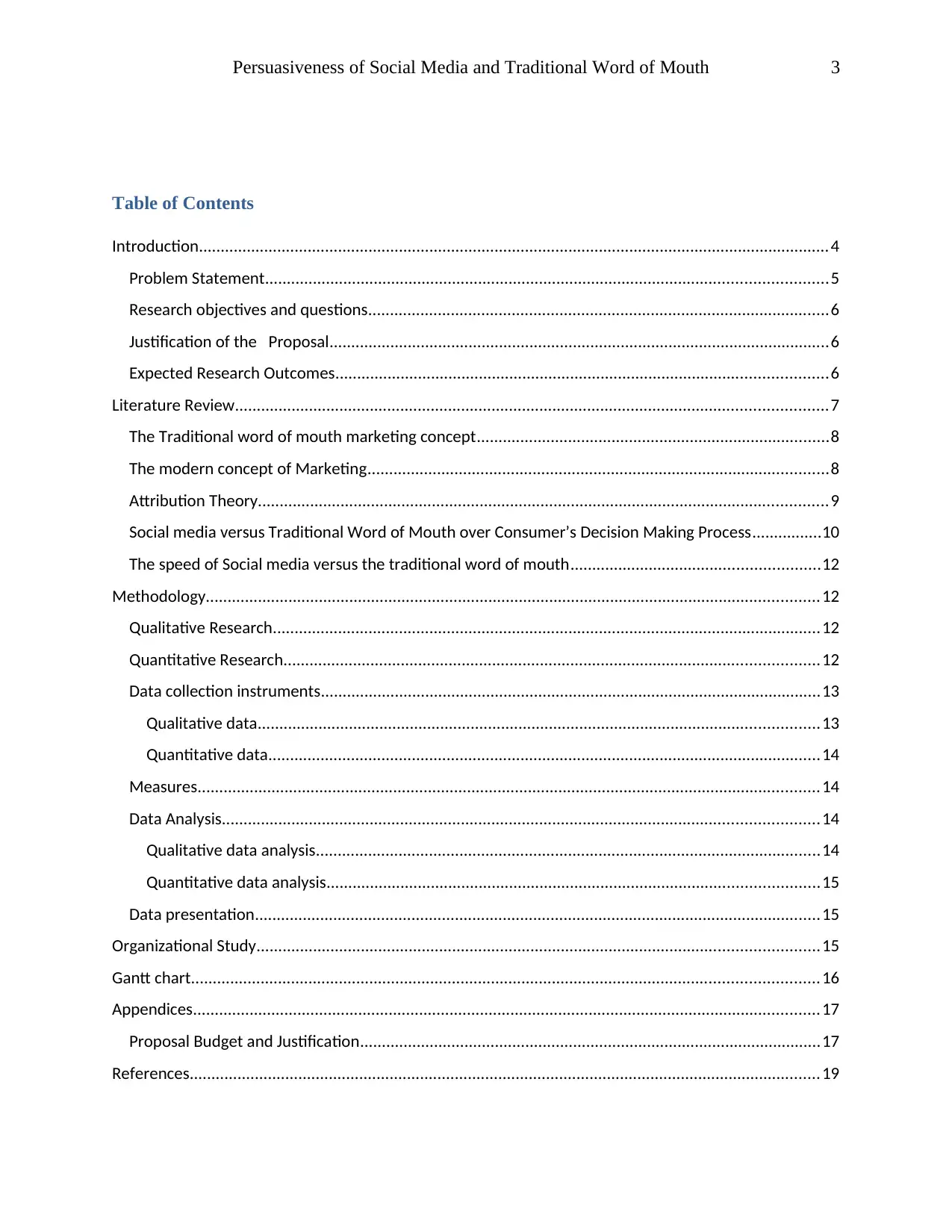
Persuasiveness of Social Media and Traditional Word of Mouth 3
Table of Contents
Introduction.................................................................................................................................................4
Problem Statement.................................................................................................................................5
Research objectives and questions..........................................................................................................6
Justification of the Proposal...................................................................................................................6
Expected Research Outcomes.................................................................................................................6
Literature Review........................................................................................................................................7
The Traditional word of mouth marketing concept.................................................................................8
The modern concept of Marketing..........................................................................................................8
Attribution Theory...................................................................................................................................9
Social media versus Traditional Word of Mouth over Consumer’s Decision Making Process................10
The speed of Social media versus the traditional word of mouth.........................................................12
Methodology.............................................................................................................................................12
Qualitative Research..............................................................................................................................12
Quantitative Research...........................................................................................................................12
Data collection instruments...................................................................................................................13
Qualitative data.................................................................................................................................13
Quantitative data...............................................................................................................................14
Measures...............................................................................................................................................14
Data Analysis.........................................................................................................................................14
Qualitative data analysis....................................................................................................................14
Quantitative data analysis.................................................................................................................15
Data presentation..................................................................................................................................15
Organizational Study.................................................................................................................................15
Gantt chart................................................................................................................................................16
Appendices................................................................................................................................................17
Proposal Budget and Justification..........................................................................................................17
References.................................................................................................................................................19
Table of Contents
Introduction.................................................................................................................................................4
Problem Statement.................................................................................................................................5
Research objectives and questions..........................................................................................................6
Justification of the Proposal...................................................................................................................6
Expected Research Outcomes.................................................................................................................6
Literature Review........................................................................................................................................7
The Traditional word of mouth marketing concept.................................................................................8
The modern concept of Marketing..........................................................................................................8
Attribution Theory...................................................................................................................................9
Social media versus Traditional Word of Mouth over Consumer’s Decision Making Process................10
The speed of Social media versus the traditional word of mouth.........................................................12
Methodology.............................................................................................................................................12
Qualitative Research..............................................................................................................................12
Quantitative Research...........................................................................................................................12
Data collection instruments...................................................................................................................13
Qualitative data.................................................................................................................................13
Quantitative data...............................................................................................................................14
Measures...............................................................................................................................................14
Data Analysis.........................................................................................................................................14
Qualitative data analysis....................................................................................................................14
Quantitative data analysis.................................................................................................................15
Data presentation..................................................................................................................................15
Organizational Study.................................................................................................................................15
Gantt chart................................................................................................................................................16
Appendices................................................................................................................................................17
Proposal Budget and Justification..........................................................................................................17
References.................................................................................................................................................19
⊘ This is a preview!⊘
Do you want full access?
Subscribe today to unlock all pages.

Trusted by 1+ million students worldwide
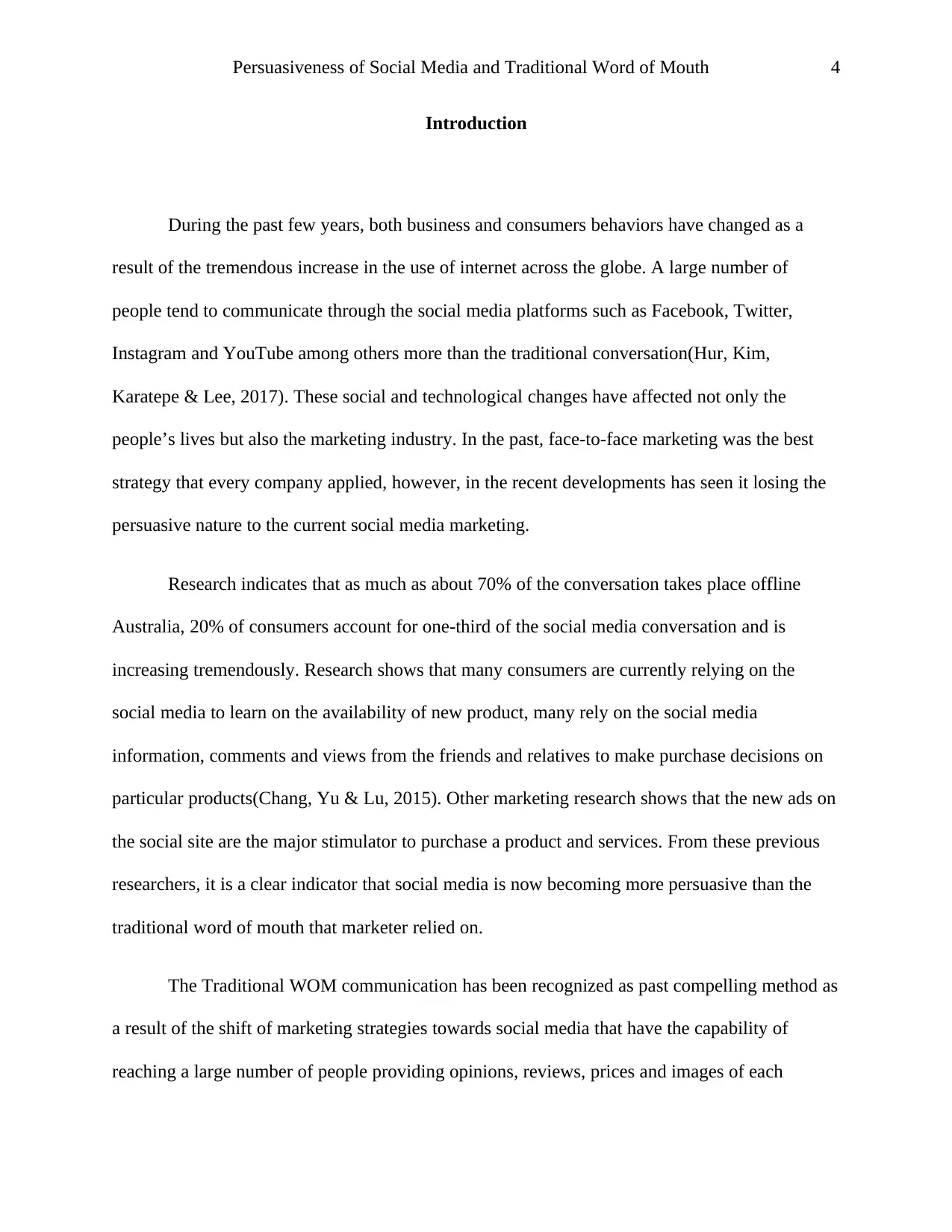
Persuasiveness of Social Media and Traditional Word of Mouth 4
Introduction
During the past few years, both business and consumers behaviors have changed as a
result of the tremendous increase in the use of internet across the globe. A large number of
people tend to communicate through the social media platforms such as Facebook, Twitter,
Instagram and YouTube among others more than the traditional conversation(Hur, Kim,
Karatepe & Lee, 2017). These social and technological changes have affected not only the
people’s lives but also the marketing industry. In the past, face-to-face marketing was the best
strategy that every company applied, however, in the recent developments has seen it losing the
persuasive nature to the current social media marketing.
Research indicates that as much as about 70% of the conversation takes place offline
Australia, 20% of consumers account for one-third of the social media conversation and is
increasing tremendously. Research shows that many consumers are currently relying on the
social media to learn on the availability of new product, many rely on the social media
information, comments and views from the friends and relatives to make purchase decisions on
particular products(Chang, Yu & Lu, 2015). Other marketing research shows that the new ads on
the social site are the major stimulator to purchase a product and services. From these previous
researchers, it is a clear indicator that social media is now becoming more persuasive than the
traditional word of mouth that marketer relied on.
The Traditional WOM communication has been recognized as past compelling method as
a result of the shift of marketing strategies towards social media that have the capability of
reaching a large number of people providing opinions, reviews, prices and images of each
Introduction
During the past few years, both business and consumers behaviors have changed as a
result of the tremendous increase in the use of internet across the globe. A large number of
people tend to communicate through the social media platforms such as Facebook, Twitter,
Instagram and YouTube among others more than the traditional conversation(Hur, Kim,
Karatepe & Lee, 2017). These social and technological changes have affected not only the
people’s lives but also the marketing industry. In the past, face-to-face marketing was the best
strategy that every company applied, however, in the recent developments has seen it losing the
persuasive nature to the current social media marketing.
Research indicates that as much as about 70% of the conversation takes place offline
Australia, 20% of consumers account for one-third of the social media conversation and is
increasing tremendously. Research shows that many consumers are currently relying on the
social media to learn on the availability of new product, many rely on the social media
information, comments and views from the friends and relatives to make purchase decisions on
particular products(Chang, Yu & Lu, 2015). Other marketing research shows that the new ads on
the social site are the major stimulator to purchase a product and services. From these previous
researchers, it is a clear indicator that social media is now becoming more persuasive than the
traditional word of mouth that marketer relied on.
The Traditional WOM communication has been recognized as past compelling method as
a result of the shift of marketing strategies towards social media that have the capability of
reaching a large number of people providing opinions, reviews, prices and images of each
Paraphrase This Document
Need a fresh take? Get an instant paraphrase of this document with our AI Paraphraser
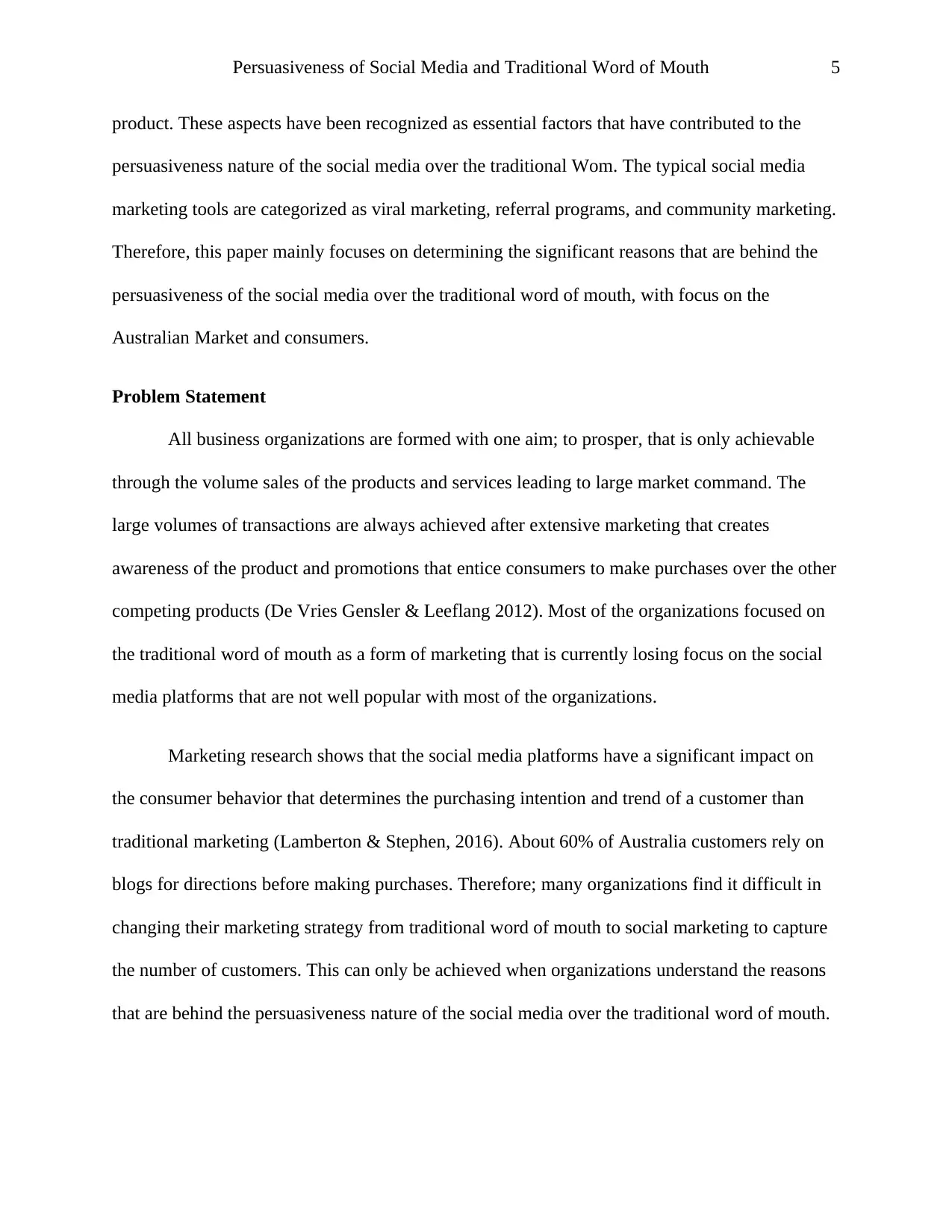
Persuasiveness of Social Media and Traditional Word of Mouth 5
product. These aspects have been recognized as essential factors that have contributed to the
persuasiveness nature of the social media over the traditional Wom. The typical social media
marketing tools are categorized as viral marketing, referral programs, and community marketing.
Therefore, this paper mainly focuses on determining the significant reasons that are behind the
persuasiveness of the social media over the traditional word of mouth, with focus on the
Australian Market and consumers.
Problem Statement
All business organizations are formed with one aim; to prosper, that is only achievable
through the volume sales of the products and services leading to large market command. The
large volumes of transactions are always achieved after extensive marketing that creates
awareness of the product and promotions that entice consumers to make purchases over the other
competing products (De Vries Gensler & Leeflang 2012). Most of the organizations focused on
the traditional word of mouth as a form of marketing that is currently losing focus on the social
media platforms that are not well popular with most of the organizations.
Marketing research shows that the social media platforms have a significant impact on
the consumer behavior that determines the purchasing intention and trend of a customer than
traditional marketing (Lamberton & Stephen, 2016). About 60% of Australia customers rely on
blogs for directions before making purchases. Therefore; many organizations find it difficult in
changing their marketing strategy from traditional word of mouth to social marketing to capture
the number of customers. This can only be achieved when organizations understand the reasons
that are behind the persuasiveness nature of the social media over the traditional word of mouth.
product. These aspects have been recognized as essential factors that have contributed to the
persuasiveness nature of the social media over the traditional Wom. The typical social media
marketing tools are categorized as viral marketing, referral programs, and community marketing.
Therefore, this paper mainly focuses on determining the significant reasons that are behind the
persuasiveness of the social media over the traditional word of mouth, with focus on the
Australian Market and consumers.
Problem Statement
All business organizations are formed with one aim; to prosper, that is only achievable
through the volume sales of the products and services leading to large market command. The
large volumes of transactions are always achieved after extensive marketing that creates
awareness of the product and promotions that entice consumers to make purchases over the other
competing products (De Vries Gensler & Leeflang 2012). Most of the organizations focused on
the traditional word of mouth as a form of marketing that is currently losing focus on the social
media platforms that are not well popular with most of the organizations.
Marketing research shows that the social media platforms have a significant impact on
the consumer behavior that determines the purchasing intention and trend of a customer than
traditional marketing (Lamberton & Stephen, 2016). About 60% of Australia customers rely on
blogs for directions before making purchases. Therefore; many organizations find it difficult in
changing their marketing strategy from traditional word of mouth to social marketing to capture
the number of customers. This can only be achieved when organizations understand the reasons
that are behind the persuasiveness nature of the social media over the traditional word of mouth.
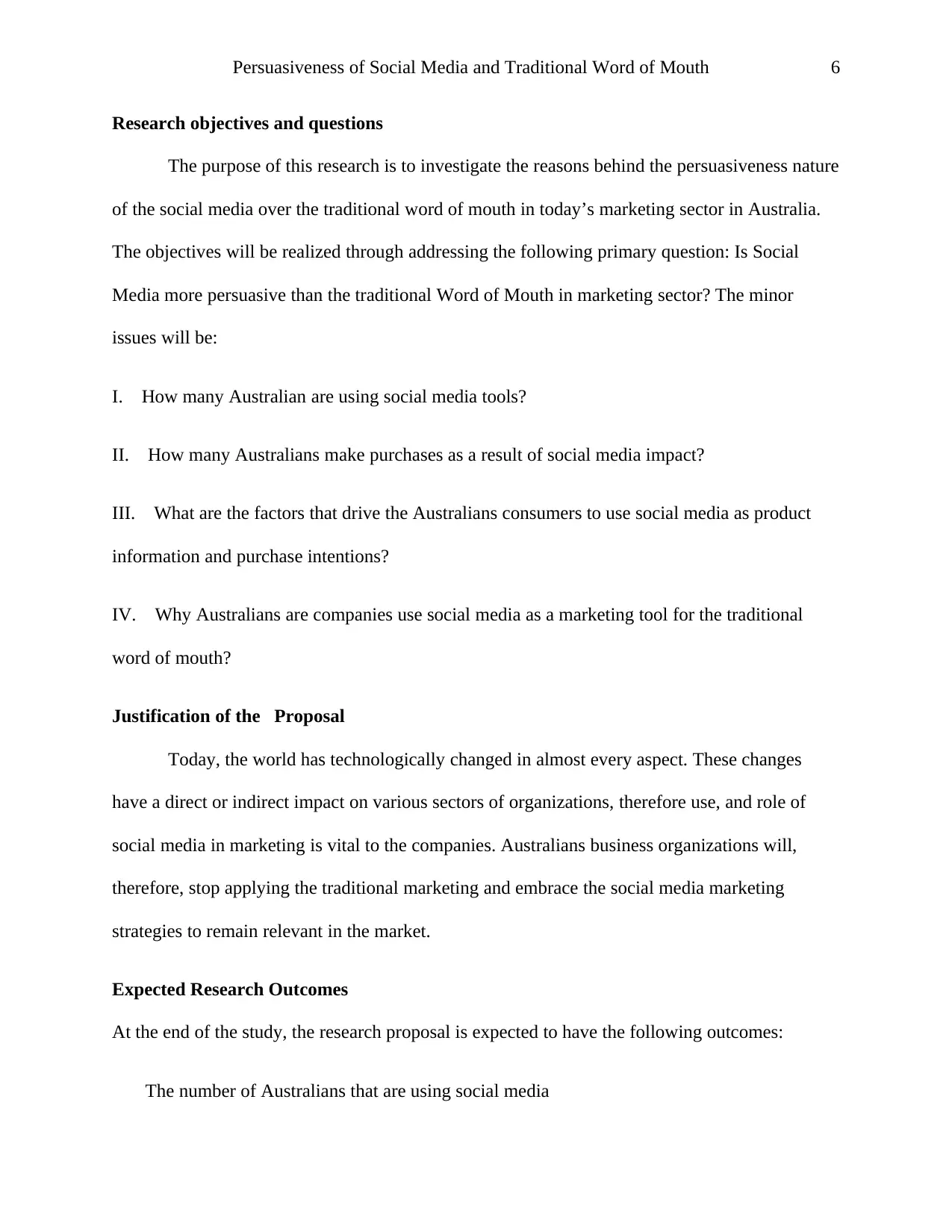
Persuasiveness of Social Media and Traditional Word of Mouth 6
Research objectives and questions
The purpose of this research is to investigate the reasons behind the persuasiveness nature
of the social media over the traditional word of mouth in today’s marketing sector in Australia.
The objectives will be realized through addressing the following primary question: Is Social
Media more persuasive than the traditional Word of Mouth in marketing sector? The minor
issues will be:
I. How many Australian are using social media tools?
II. How many Australians make purchases as a result of social media impact?
III. What are the factors that drive the Australians consumers to use social media as product
information and purchase intentions?
IV. Why Australians are companies use social media as a marketing tool for the traditional
word of mouth?
Justification of the Proposal
Today, the world has technologically changed in almost every aspect. These changes
have a direct or indirect impact on various sectors of organizations, therefore use, and role of
social media in marketing is vital to the companies. Australians business organizations will,
therefore, stop applying the traditional marketing and embrace the social media marketing
strategies to remain relevant in the market.
Expected Research Outcomes
At the end of the study, the research proposal is expected to have the following outcomes:
The number of Australians that are using social media
Research objectives and questions
The purpose of this research is to investigate the reasons behind the persuasiveness nature
of the social media over the traditional word of mouth in today’s marketing sector in Australia.
The objectives will be realized through addressing the following primary question: Is Social
Media more persuasive than the traditional Word of Mouth in marketing sector? The minor
issues will be:
I. How many Australian are using social media tools?
II. How many Australians make purchases as a result of social media impact?
III. What are the factors that drive the Australians consumers to use social media as product
information and purchase intentions?
IV. Why Australians are companies use social media as a marketing tool for the traditional
word of mouth?
Justification of the Proposal
Today, the world has technologically changed in almost every aspect. These changes
have a direct or indirect impact on various sectors of organizations, therefore use, and role of
social media in marketing is vital to the companies. Australians business organizations will,
therefore, stop applying the traditional marketing and embrace the social media marketing
strategies to remain relevant in the market.
Expected Research Outcomes
At the end of the study, the research proposal is expected to have the following outcomes:
The number of Australians that are using social media
⊘ This is a preview!⊘
Do you want full access?
Subscribe today to unlock all pages.

Trusted by 1+ million students worldwide
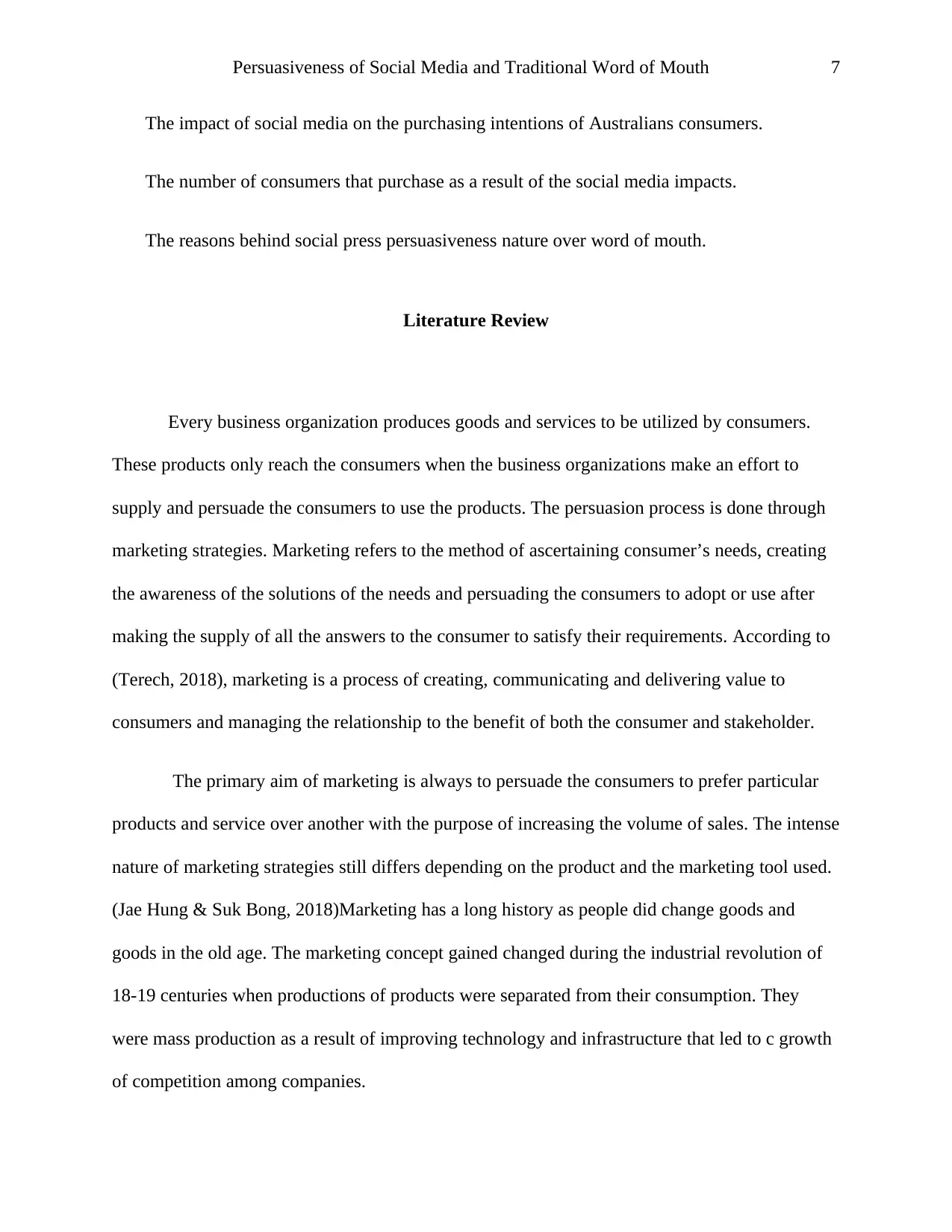
Persuasiveness of Social Media and Traditional Word of Mouth 7
The impact of social media on the purchasing intentions of Australians consumers.
The number of consumers that purchase as a result of the social media impacts.
The reasons behind social press persuasiveness nature over word of mouth.
Literature Review
Every business organization produces goods and services to be utilized by consumers.
These products only reach the consumers when the business organizations make an effort to
supply and persuade the consumers to use the products. The persuasion process is done through
marketing strategies. Marketing refers to the method of ascertaining consumer’s needs, creating
the awareness of the solutions of the needs and persuading the consumers to adopt or use after
making the supply of all the answers to the consumer to satisfy their requirements. According to
(Terech, 2018), marketing is a process of creating, communicating and delivering value to
consumers and managing the relationship to the benefit of both the consumer and stakeholder.
The primary aim of marketing is always to persuade the consumers to prefer particular
products and service over another with the purpose of increasing the volume of sales. The intense
nature of marketing strategies still differs depending on the product and the marketing tool used.
(Jae Hung & Suk Bong, 2018)Marketing has a long history as people did change goods and
goods in the old age. The marketing concept gained changed during the industrial revolution of
18-19 centuries when productions of products were separated from their consumption. They
were mass production as a result of improving technology and infrastructure that led to c growth
of competition among companies.
The impact of social media on the purchasing intentions of Australians consumers.
The number of consumers that purchase as a result of the social media impacts.
The reasons behind social press persuasiveness nature over word of mouth.
Literature Review
Every business organization produces goods and services to be utilized by consumers.
These products only reach the consumers when the business organizations make an effort to
supply and persuade the consumers to use the products. The persuasion process is done through
marketing strategies. Marketing refers to the method of ascertaining consumer’s needs, creating
the awareness of the solutions of the needs and persuading the consumers to adopt or use after
making the supply of all the answers to the consumer to satisfy their requirements. According to
(Terech, 2018), marketing is a process of creating, communicating and delivering value to
consumers and managing the relationship to the benefit of both the consumer and stakeholder.
The primary aim of marketing is always to persuade the consumers to prefer particular
products and service over another with the purpose of increasing the volume of sales. The intense
nature of marketing strategies still differs depending on the product and the marketing tool used.
(Jae Hung & Suk Bong, 2018)Marketing has a long history as people did change goods and
goods in the old age. The marketing concept gained changed during the industrial revolution of
18-19 centuries when productions of products were separated from their consumption. They
were mass production as a result of improving technology and infrastructure that led to c growth
of competition among companies.
Paraphrase This Document
Need a fresh take? Get an instant paraphrase of this document with our AI Paraphraser
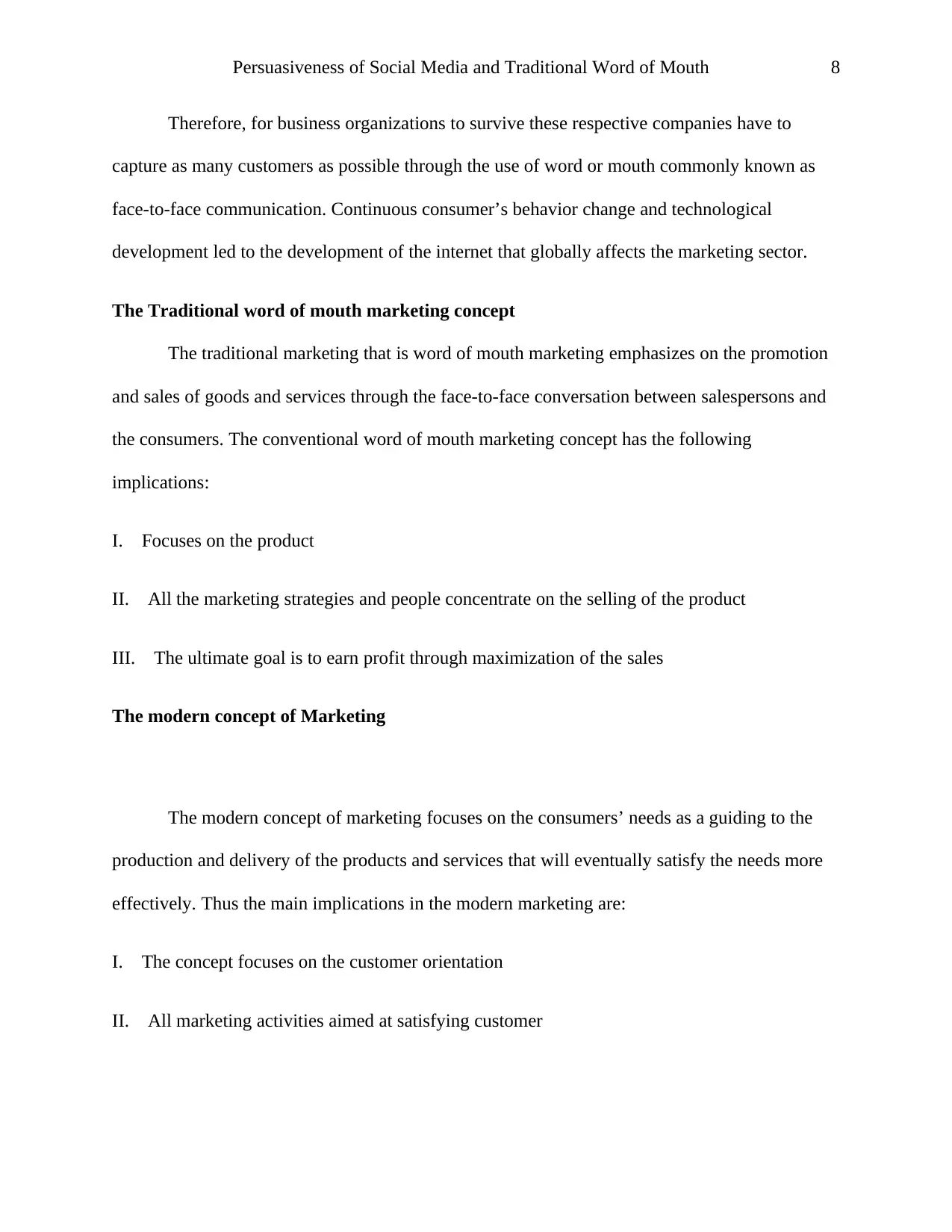
Persuasiveness of Social Media and Traditional Word of Mouth 8
Therefore, for business organizations to survive these respective companies have to
capture as many customers as possible through the use of word or mouth commonly known as
face-to-face communication. Continuous consumer’s behavior change and technological
development led to the development of the internet that globally affects the marketing sector.
The Traditional word of mouth marketing concept
The traditional marketing that is word of mouth marketing emphasizes on the promotion
and sales of goods and services through the face-to-face conversation between salespersons and
the consumers. The conventional word of mouth marketing concept has the following
implications:
I. Focuses on the product
II. All the marketing strategies and people concentrate on the selling of the product
III. The ultimate goal is to earn profit through maximization of the sales
The modern concept of Marketing
The modern concept of marketing focuses on the consumers’ needs as a guiding to the
production and delivery of the products and services that will eventually satisfy the needs more
effectively. Thus the main implications in the modern marketing are:
I. The concept focuses on the customer orientation
II. All marketing activities aimed at satisfying customer
Therefore, for business organizations to survive these respective companies have to
capture as many customers as possible through the use of word or mouth commonly known as
face-to-face communication. Continuous consumer’s behavior change and technological
development led to the development of the internet that globally affects the marketing sector.
The Traditional word of mouth marketing concept
The traditional marketing that is word of mouth marketing emphasizes on the promotion
and sales of goods and services through the face-to-face conversation between salespersons and
the consumers. The conventional word of mouth marketing concept has the following
implications:
I. Focuses on the product
II. All the marketing strategies and people concentrate on the selling of the product
III. The ultimate goal is to earn profit through maximization of the sales
The modern concept of Marketing
The modern concept of marketing focuses on the consumers’ needs as a guiding to the
production and delivery of the products and services that will eventually satisfy the needs more
effectively. Thus the main implications in the modern marketing are:
I. The concept focuses on the customer orientation
II. All marketing activities aimed at satisfying customer
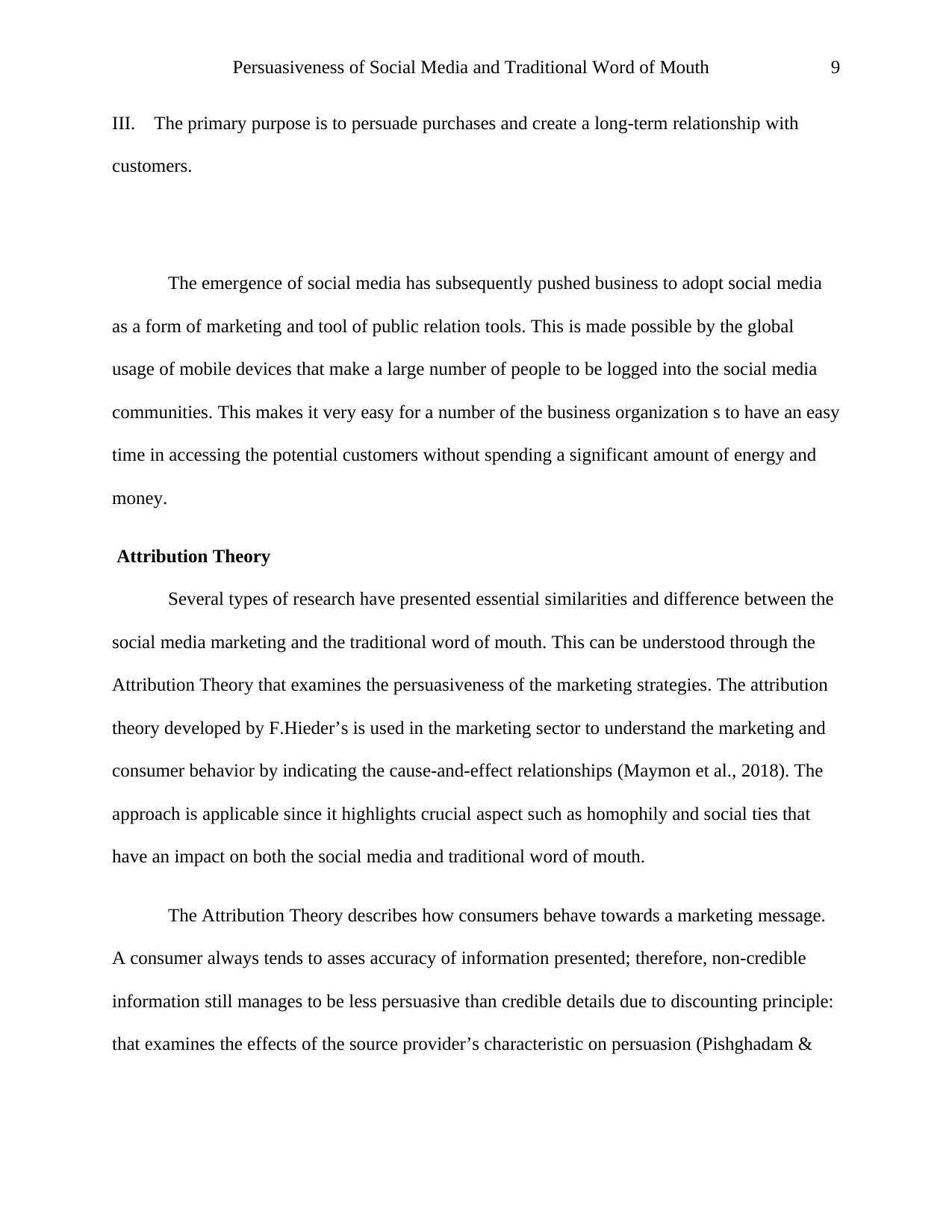
Persuasiveness of Social Media and Traditional Word of Mouth 9
III. The primary purpose is to persuade purchases and create a long-term relationship with
customers.
The emergence of social media has subsequently pushed business to adopt social media
as a form of marketing and tool of public relation tools. This is made possible by the global
usage of mobile devices that make a large number of people to be logged into the social media
communities. This makes it very easy for a number of the business organization s to have an easy
time in accessing the potential customers without spending a significant amount of energy and
money.
Attribution Theory
Several types of research have presented essential similarities and difference between the
social media marketing and the traditional word of mouth. This can be understood through the
Attribution Theory that examines the persuasiveness of the marketing strategies. The attribution
theory developed by F.Hieder’s is used in the marketing sector to understand the marketing and
consumer behavior by indicating the cause-and-effect relationships (Maymon et al., 2018). The
approach is applicable since it highlights crucial aspect such as homophily and social ties that
have an impact on both the social media and traditional word of mouth.
The Attribution Theory describes how consumers behave towards a marketing message.
A consumer always tends to asses accuracy of information presented; therefore, non-credible
information still manages to be less persuasive than credible details due to discounting principle:
that examines the effects of the source provider’s characteristic on persuasion (Pishghadam &
III. The primary purpose is to persuade purchases and create a long-term relationship with
customers.
The emergence of social media has subsequently pushed business to adopt social media
as a form of marketing and tool of public relation tools. This is made possible by the global
usage of mobile devices that make a large number of people to be logged into the social media
communities. This makes it very easy for a number of the business organization s to have an easy
time in accessing the potential customers without spending a significant amount of energy and
money.
Attribution Theory
Several types of research have presented essential similarities and difference between the
social media marketing and the traditional word of mouth. This can be understood through the
Attribution Theory that examines the persuasiveness of the marketing strategies. The attribution
theory developed by F.Hieder’s is used in the marketing sector to understand the marketing and
consumer behavior by indicating the cause-and-effect relationships (Maymon et al., 2018). The
approach is applicable since it highlights crucial aspect such as homophily and social ties that
have an impact on both the social media and traditional word of mouth.
The Attribution Theory describes how consumers behave towards a marketing message.
A consumer always tends to asses accuracy of information presented; therefore, non-credible
information still manages to be less persuasive than credible details due to discounting principle:
that examines the effects of the source provider’s characteristic on persuasion (Pishghadam &
⊘ This is a preview!⊘
Do you want full access?
Subscribe today to unlock all pages.

Trusted by 1+ million students worldwide
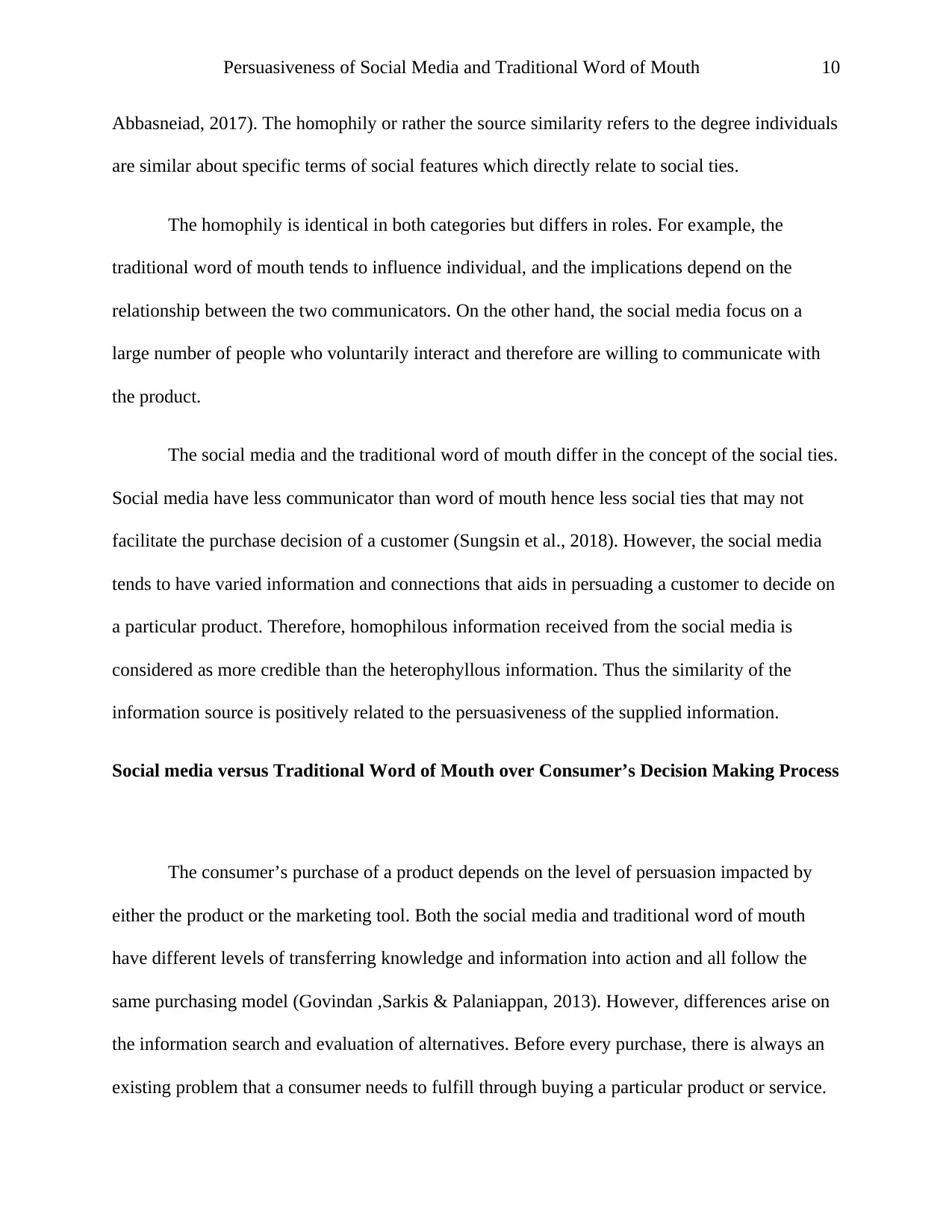
Persuasiveness of Social Media and Traditional Word of Mouth 10
Abbasneiad, 2017). The homophily or rather the source similarity refers to the degree individuals
are similar about specific terms of social features which directly relate to social ties.
The homophily is identical in both categories but differs in roles. For example, the
traditional word of mouth tends to influence individual, and the implications depend on the
relationship between the two communicators. On the other hand, the social media focus on a
large number of people who voluntarily interact and therefore are willing to communicate with
the product.
The social media and the traditional word of mouth differ in the concept of the social ties.
Social media have less communicator than word of mouth hence less social ties that may not
facilitate the purchase decision of a customer (Sungsin et al., 2018). However, the social media
tends to have varied information and connections that aids in persuading a customer to decide on
a particular product. Therefore, homophilous information received from the social media is
considered as more credible than the heterophyllous information. Thus the similarity of the
information source is positively related to the persuasiveness of the supplied information.
Social media versus Traditional Word of Mouth over Consumer’s Decision Making Process
The consumer’s purchase of a product depends on the level of persuasion impacted by
either the product or the marketing tool. Both the social media and traditional word of mouth
have different levels of transferring knowledge and information into action and all follow the
same purchasing model (Govindan ,Sarkis & Palaniappan, 2013). However, differences arise on
the information search and evaluation of alternatives. Before every purchase, there is always an
existing problem that a consumer needs to fulfill through buying a particular product or service.
Abbasneiad, 2017). The homophily or rather the source similarity refers to the degree individuals
are similar about specific terms of social features which directly relate to social ties.
The homophily is identical in both categories but differs in roles. For example, the
traditional word of mouth tends to influence individual, and the implications depend on the
relationship between the two communicators. On the other hand, the social media focus on a
large number of people who voluntarily interact and therefore are willing to communicate with
the product.
The social media and the traditional word of mouth differ in the concept of the social ties.
Social media have less communicator than word of mouth hence less social ties that may not
facilitate the purchase decision of a customer (Sungsin et al., 2018). However, the social media
tends to have varied information and connections that aids in persuading a customer to decide on
a particular product. Therefore, homophilous information received from the social media is
considered as more credible than the heterophyllous information. Thus the similarity of the
information source is positively related to the persuasiveness of the supplied information.
Social media versus Traditional Word of Mouth over Consumer’s Decision Making Process
The consumer’s purchase of a product depends on the level of persuasion impacted by
either the product or the marketing tool. Both the social media and traditional word of mouth
have different levels of transferring knowledge and information into action and all follow the
same purchasing model (Govindan ,Sarkis & Palaniappan, 2013). However, differences arise on
the information search and evaluation of alternatives. Before every purchase, there is always an
existing problem that a consumer needs to fulfill through buying a particular product or service.
Paraphrase This Document
Need a fresh take? Get an instant paraphrase of this document with our AI Paraphraser
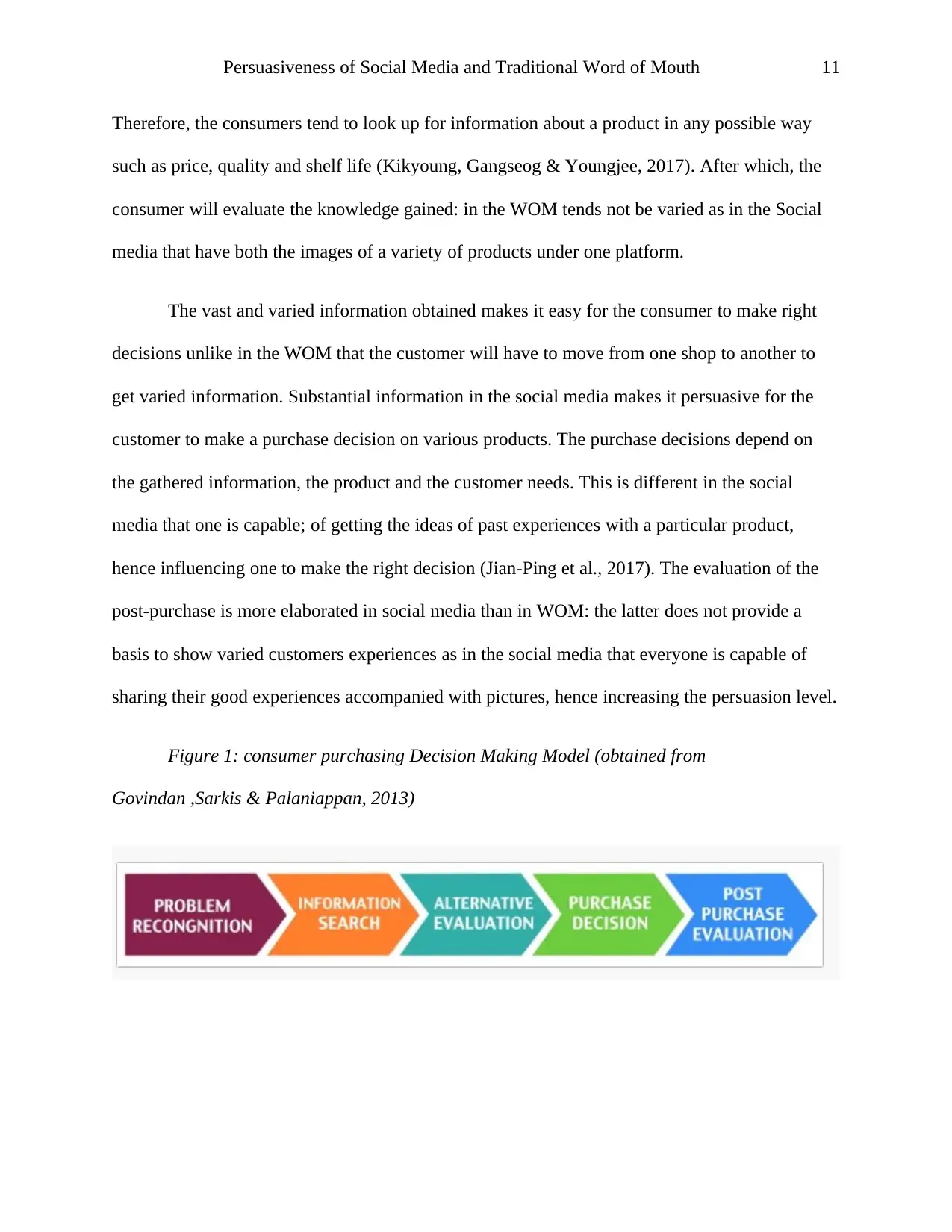
Persuasiveness of Social Media and Traditional Word of Mouth 11
Therefore, the consumers tend to look up for information about a product in any possible way
such as price, quality and shelf life (Kikyoung, Gangseog & Youngjee, 2017). After which, the
consumer will evaluate the knowledge gained: in the WOM tends not be varied as in the Social
media that have both the images of a variety of products under one platform.
The vast and varied information obtained makes it easy for the consumer to make right
decisions unlike in the WOM that the customer will have to move from one shop to another to
get varied information. Substantial information in the social media makes it persuasive for the
customer to make a purchase decision on various products. The purchase decisions depend on
the gathered information, the product and the customer needs. This is different in the social
media that one is capable; of getting the ideas of past experiences with a particular product,
hence influencing one to make the right decision (Jian-Ping et al., 2017). The evaluation of the
post-purchase is more elaborated in social media than in WOM: the latter does not provide a
basis to show varied customers experiences as in the social media that everyone is capable of
sharing their good experiences accompanied with pictures, hence increasing the persuasion level.
Figure 1: consumer purchasing Decision Making Model (obtained from
Govindan ,Sarkis & Palaniappan, 2013)
Therefore, the consumers tend to look up for information about a product in any possible way
such as price, quality and shelf life (Kikyoung, Gangseog & Youngjee, 2017). After which, the
consumer will evaluate the knowledge gained: in the WOM tends not be varied as in the Social
media that have both the images of a variety of products under one platform.
The vast and varied information obtained makes it easy for the consumer to make right
decisions unlike in the WOM that the customer will have to move from one shop to another to
get varied information. Substantial information in the social media makes it persuasive for the
customer to make a purchase decision on various products. The purchase decisions depend on
the gathered information, the product and the customer needs. This is different in the social
media that one is capable; of getting the ideas of past experiences with a particular product,
hence influencing one to make the right decision (Jian-Ping et al., 2017). The evaluation of the
post-purchase is more elaborated in social media than in WOM: the latter does not provide a
basis to show varied customers experiences as in the social media that everyone is capable of
sharing their good experiences accompanied with pictures, hence increasing the persuasion level.
Figure 1: consumer purchasing Decision Making Model (obtained from
Govindan ,Sarkis & Palaniappan, 2013)
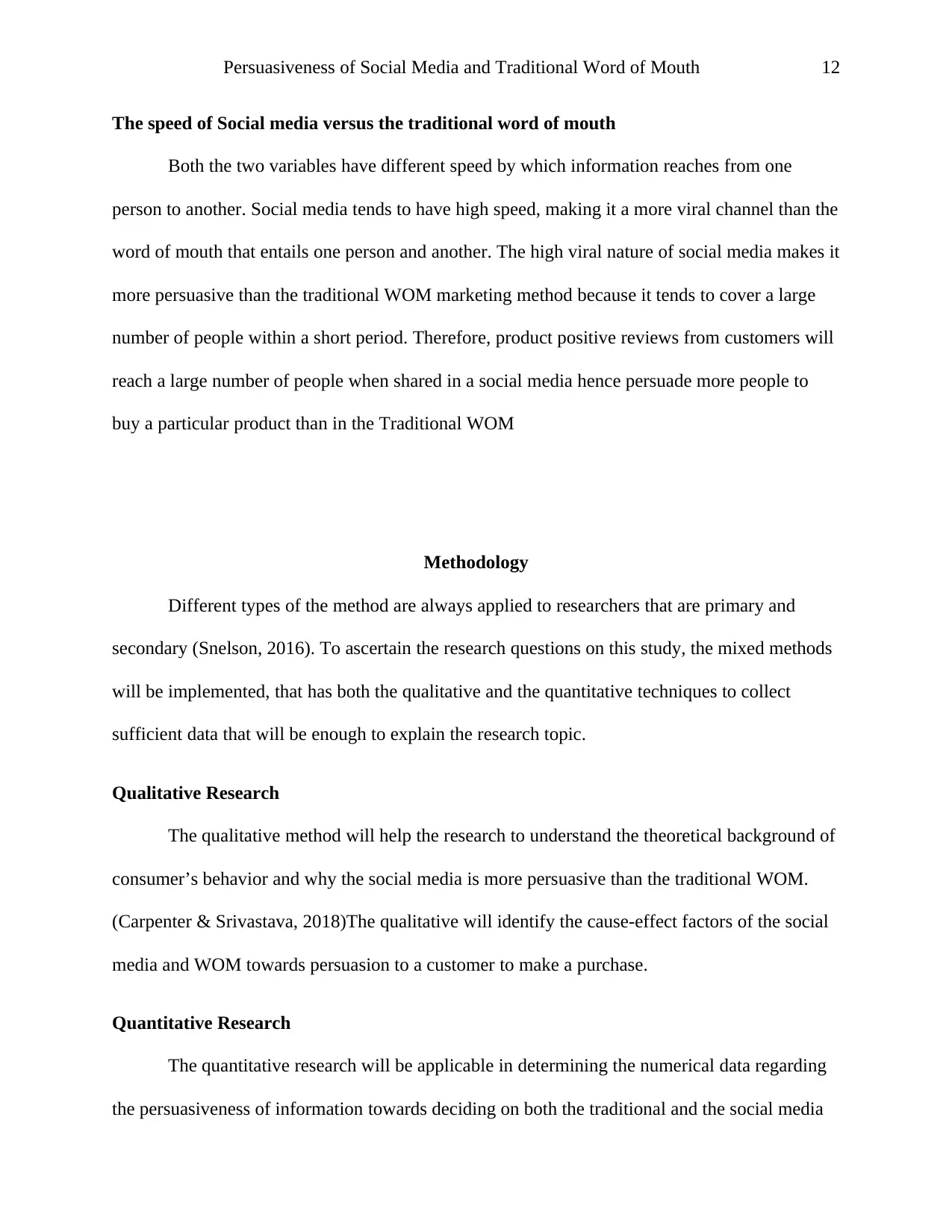
Persuasiveness of Social Media and Traditional Word of Mouth 12
The speed of Social media versus the traditional word of mouth
Both the two variables have different speed by which information reaches from one
person to another. Social media tends to have high speed, making it a more viral channel than the
word of mouth that entails one person and another. The high viral nature of social media makes it
more persuasive than the traditional WOM marketing method because it tends to cover a large
number of people within a short period. Therefore, product positive reviews from customers will
reach a large number of people when shared in a social media hence persuade more people to
buy a particular product than in the Traditional WOM
Methodology
Different types of the method are always applied to researchers that are primary and
secondary (Snelson, 2016). To ascertain the research questions on this study, the mixed methods
will be implemented, that has both the qualitative and the quantitative techniques to collect
sufficient data that will be enough to explain the research topic.
Qualitative Research
The qualitative method will help the research to understand the theoretical background of
consumer’s behavior and why the social media is more persuasive than the traditional WOM.
(Carpenter & Srivastava, 2018)The qualitative will identify the cause-effect factors of the social
media and WOM towards persuasion to a customer to make a purchase.
Quantitative Research
The quantitative research will be applicable in determining the numerical data regarding
the persuasiveness of information towards deciding on both the traditional and the social media
The speed of Social media versus the traditional word of mouth
Both the two variables have different speed by which information reaches from one
person to another. Social media tends to have high speed, making it a more viral channel than the
word of mouth that entails one person and another. The high viral nature of social media makes it
more persuasive than the traditional WOM marketing method because it tends to cover a large
number of people within a short period. Therefore, product positive reviews from customers will
reach a large number of people when shared in a social media hence persuade more people to
buy a particular product than in the Traditional WOM
Methodology
Different types of the method are always applied to researchers that are primary and
secondary (Snelson, 2016). To ascertain the research questions on this study, the mixed methods
will be implemented, that has both the qualitative and the quantitative techniques to collect
sufficient data that will be enough to explain the research topic.
Qualitative Research
The qualitative method will help the research to understand the theoretical background of
consumer’s behavior and why the social media is more persuasive than the traditional WOM.
(Carpenter & Srivastava, 2018)The qualitative will identify the cause-effect factors of the social
media and WOM towards persuasion to a customer to make a purchase.
Quantitative Research
The quantitative research will be applicable in determining the numerical data regarding
the persuasiveness of information towards deciding on both the traditional and the social media
⊘ This is a preview!⊘
Do you want full access?
Subscribe today to unlock all pages.

Trusted by 1+ million students worldwide
1 out of 22
Related Documents
Your All-in-One AI-Powered Toolkit for Academic Success.
+13062052269
info@desklib.com
Available 24*7 on WhatsApp / Email
![[object Object]](/_next/static/media/star-bottom.7253800d.svg)
Unlock your academic potential
Copyright © 2020–2025 A2Z Services. All Rights Reserved. Developed and managed by ZUCOL.





